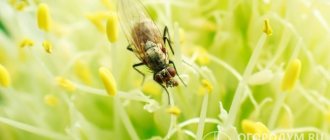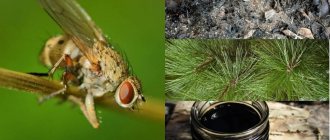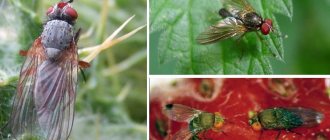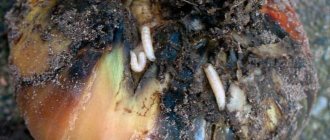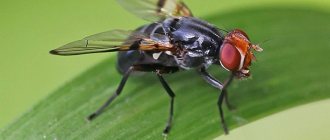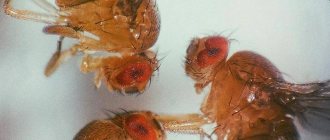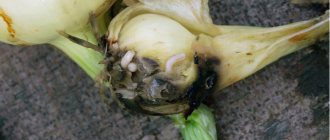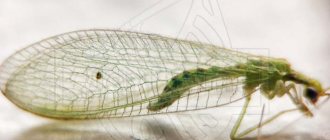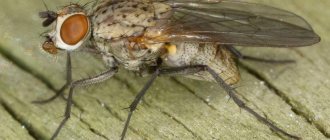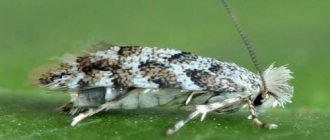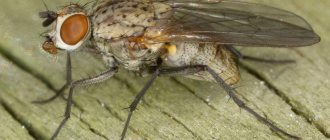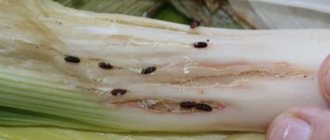Experienced gardeners will agree: it is not possible to grow a rich harvest of onions every year. And with such a “helper” as the onion fly, one can only dream of a juicy feather and a tight turnip. The onions were eaten by “some white worms,” gardeners sadly state.
The trouble is that the onion fly does its damage unnoticed. For example, everyone recognizes the Colorado potato beetle, which methodically gnaws potato leaves, and what the onion pest looks like, gardeners begin to become interested when someone suggests the probable cause of the loss of the crop. And not only onions, but also garlic!
The choice of an insect seems strange, because onions and garlic are powerful antioxidants with a pronounced phytoncidal effect. Healthy vegetables kill viruses and bacteria, but cannot cope with one pest. If there is an onion fly in your garden beds, there are two options: stop planting onions and garlic, or find out how to fight the onion fly and get rid of the harmful insect forever.
What does an onion fly look like?
Many representatives of the order Diptera are similar to each other, and you need to be an entomologist to be sure to recognize a specific species. Imagine an ordinary housefly, only smaller, about 5-7 mm long. If you want to get to know each other better, look for onion flies in the spring on dandelion or cherry flowers.
You can recognize the pest by its yellowish-gray body color and transparent wings with a bronze tint. Armed with a magnifying glass or high-quality photos of the onion fly, you will see black legs and fleecy bristles on the back.
Adult onion flies (imago) are real gourmets and do not feed on onions or garlic. Their food preferences include the sweet nectar of aster plants and stone fruit trees. But the onion and garlic aromas are extremely attractive to females, who flock to the beds to lay their eggs there. Therefore, it is important to study the developmental features of insects in order to understand how they spoil the crop.
Onion fly.
Onion fly.
Reviews
Before planting onions, I always soak them in warm salted water for 3 hours - dissolve 1 tbsp in 1 liter of water. with a heap of salt. I use only coarse kitchen salt. And still, every time I pick onions for a fresh salad, they tear off the feathers and check to see if there are any worms there. Anything can happen.
Stefania, 41 years old, Bryansk
We never hope that the onion fly can be scared away by the smell of grass and flowers, and therefore we always prepare the soil in advance. In addition to kerosene, I sometimes use birch tar. If they pour trenches under onions or potatoes in the spring, there will be no onion fly or Colorado potato beetle.
Gleb, 35 years old Orekhovo-Zuevo
I am not afraid to use chemicals and always use them in my garden, not only for onions, but also for all vegetable crops. The main thing is to follow the manufacturer's instructions, not to increase the concentration of the solutions, and stop using them in a timely manner. For onions, I use the “Fly-eater” product, which is applied to the soil before planting the onions. It acts not only on fly larvae: all pests that are in the soil at this time disappear. I believe that spring prevention is much more effective than summer insect control.
Grigory, 55 years old, Tolyatti
Natalia
Author
Ask a Question
The hook fly, like the hoverfly and carrot fly, do not necessarily have to become a scourge that you have to fight with all summer. Pre-prepared and disinfected soil will guarantee that onion beds will not grow heads in which insects will swarm. Any stray fly will not want its offspring to be in the ground from which the pungent smell of the same kerosene emanates. It is within the power of any gardener to protect his plants from pests. Health to you and your loved ones!
Life cycle of onion fly
Egg – larva – pupa – imago. Most dipterans undergo this development; the onion fly is no exception. The emergence and mating of adult insects coincides with the first wave of dandelion flowering. Having filled themselves with sweet nectar, females look for beds with onions and garlic, and are primarily attracted by well-grown winter seedlings.
Egg - larva
During her life, one female lays about 60 eggs in small portions. The choice of places is strictly defined: either directly on the ground near the onion and garlic plantings, or on young greens at the base of the bulb. It is difficult to notice the masonry with the naked eye. The eggs are oblong, white, no more than a millimeter, with a dark stripe along their entire length.
Larva - pupa
The larvae develop very quickly, within 2-4 days, stretch the egg shell, break through and get out. These are the same “white worms” that are found in rotten bulbs. The whitish-cream color of the larva really looks like a worm.
There are about 15 eggs in one clutch of onion fly. Fortunately, in our gardens there are birds that feed on the eggs and larvae of insects and predatory insects that eat their own kind. Some of the larvae die, but the survivors remain very friendly and immediately bite into the nearest onion.
One family of onion fly larvae can eat almost all the pulp. When one bulb becomes not enough for everyone, the larvae move to neighboring ones through the bottom. In about 2-3 weeks they eat the onion from the inside, increasing in size to 10 mm.
Larvae feeding on leeks.
Larvae feeding on leeks.
Pupa – imago
At the next stage of development, the larvae leave the bulb, climb into the soil to a depth of about 20 cm and pupate. The onion fly pupa resembles a brick-colored barrel.
Onion fly pupae in root vegetables.
The insect stays in the pupal stage for up to 3 weeks, after which the adult onion fly emerges and the cycle repeats. Considering that females of the first and second generations lay eggs in portions, the larvae eat the crop all summer. Insects that did not have time to fly out before the onset of cold weather successfully overwinter in the soil or are sent for storage along with the surviving bulbs.
Where does this onion grief come from and how did hardworking gardeners deserve such a “gift”?
How does plant infection occur?
The insect's flight begins in the spring during the flowering of lilacs and dandelions, and lasts about 2 weeks. This period falls on the second half of May. The female lays 40-60 eggs during her life.
Soon after emergence, the female looks for a place to lay eggs. Eggs are laid at the base of the bulb, under the first dry scales, between the leaves or on the soil near the plant. Eggs mature within 3-8 days depending on weather conditions.
The hatched larvae continue to stick together. Immediately after birth, they bite into the flesh of the bottom and feed, scraping out the fleshy scales of the young onion. The insect remains in this stage for approximately 3 weeks. Baby flies are highly voracious and are able to eat not only multiple passages inside the bulb, but also large cavities.
Having eaten their fill, the larvae go into the ground next to the damaged bulb, pupate and form in this shelter for another twenty days. During this period, they already have the rudiments of wings. And in June, the flight of the second generation of flies begins, the larvae of which damage bulbous plants of late planting dates. In the southern regions, the onion fly can have 3 generations over the summer.
Only pupae overwinter, burrowing into the ground to a depth of 5-20 cm. And in May the cycle begins anew.
Onion fly: causes of appearance
Onion flies don't have to fly far. In one garden or another, pests will find unprotected beds of onions and garlic, which they will happily take advantage of.
Since these are insects and not an infection, the damage depends on the number of larvae. In the first year, only a few bulbs are affected, and if a person is faced with the problem for the first time, he may not attach any importance to this: well, a few bulbs have rotted, no problem. And without knowing it, we continue to step on the same rake:
- we do not attach importance to the quality of planting material;
- We do not carry out pre-sowing treatment of seedlings;
- We do not observe crop rotation;
- we are too lazy to dig up the beds before frost;
- We ignore basic preventive measures against pests.
The onion fly doesn’t need much; it will lay eggs once in the garden bed and the offspring, undisturbed by anyone, will continue in the same spirit. Unfortunately, many realize it when the crop loss reaches 50-70%, and the remaining 30% will probably rot in the boxes in the next month. But recognizing the “markers” of a pest is not at all difficult.
How to get rid of it using ammonia
Ammonia is mainly purchased in pharmacies in the form of a 10% solution for inhalation. It is used both to prevent egg laying and to combat onion fly larvae. You can destroy the larva using a solution of 3 tbsp. alcohol in 10 liters of water. The root zone of onion beds is treated every 4-5 days. To repel onion flies, onion tops are sprayed every 10 days. You can use ammonia only during the first period of the onion growing season - until mid-June.
Ammonia as a fertilizer
Signs of onion fly
Healthy onion or garlic sprouts quickly, quickly grows green mass, does not turn yellow or wither. The appearance of plants affected by onion fly larvae speaks for itself:
- individual plants are noticeably lagging behind in development;
- the lower feathers of the onion turn yellow and become “snotty”;
- severely weakened plants wither;
- those that are more resilient or less affected continue to grow and get sick, but the turnip becomes unedible, soft, slippery and smells bad.
Usually it doesn’t occur to anyone to cut and look at an onion that can’t be eaten anyway. But if you do this, an unsightly picture will open: blackened, corroded tissue and a couple or three “white worms.”
It’s unpleasant and offensive, but there’s no need to lose heart. Burn the diseased vegetables along with the pests, and grow a stunning harvest next year; fortunately, there are plenty of effective ways to get rid of onion flies.
Signs of defeat
It is extremely difficult to see the larvae of this pest in the garden with the naked eye, because most often they hide in the soil.
If an onion is damaged by this pest, it will emit an unpleasant smell of rot. If the soil near the plant is loosened, it will be especially felt.
The presence of onion fly on a plant is determined by its appearance. It is able to make its way through the husk of a plant and eat its inner part - the fleshy scales. Onion heads damaged by a fly are completely unsuitable for consumption. Initial signs of damage include:
- Plants begin to rot and soften. They are lethargic and soft with a touch of rot.
- Slow onion development.
- The feathers of the plants will turn yellow or wither (what else can cause onions to turn yellow?). The plants themselves will emit a bad smell.
Methods for controlling onion fly
Man has been cultivating onions for about 5 thousand years, and the onion fly did not appear yesterday. Insecticides were invented in the last century; until then, farmers fought the pest using traditional methods. Following the traditions of ancestors or choosing chemical know-how is a personal matter for each gardener.
Insecticides against onion fly
Insecticidal preparations are really good when spraying fruit trees and shrubs at the beginning of the growing season or inedible parts of plants, such as tomato or potato tops. We eat onions whole and even when we grow them for turnips, we pinch off a couple of feathers for salad. Therefore, serious drugs must be used very carefully.
Among the popular insecticides that help in the fight against onion fly, the following are worth noting:
- "Creolin": an extremely toxic but effective drug with a wide spectrum of action. It is used in veterinary medicine, medicine and agriculture;
- "Alatar": an insecticide that contains the well-known "Karbofos". The drug is resistant to washing off and ultraviolet radiation;
- “Zemlin”: an effective remedy against various soil-dwelling pests, in parallel with the onion fly, it gets rid of garden ants and slugs;
- “Fly-eater”: a universal drug for combating any soil pests;
- "Aktara": a new generation Swiss insecticide against hundreds of vegetable pests, used regardless of weather conditions.
Despite their undeniable effectiveness, insecticidal agents tend to accumulate in plants and soil; their effects are detrimental to both harmful and beneficial insects and birds. By the way, the progenitor of modern insecticides, the well-known “DDT,” has endangered many species of birds. Therefore, it makes sense to use chemicals in critical cases, when the garden is literally infested with pests and gentle folk remedies no longer work.
Traditional methods of combating onion flies
The time-tested methods that our grandmothers used to drive out the onion fly are effective and safe, their use allows you to get a healthy, 100% healthy harvest.
Good old ammonia
The ammonia solution, with its specific aroma, repels many insect pests, including the onion fly. Dilute 50 ml of ammonia in 10 liters of water and pour it between the rows of onions and garlic. The composition for spraying is prepared in the same proportions. The first treatment is carried out after emergence of seedlings, then once a month. As a bonus, the soil is enriched with nitrogen and soil acidity is reduced.
Doctor, I would like a prescription for potassium permanganate...
A cheap, generic antiseptic called potassium permanganate was declared a precursor and explosive in 2007, so you'll likely need a prescription to purchase it. If there are any supplies left, you have an effective means to combat onion flies.
A weak solution of potassium permanganate is poured between the rows, preferably without getting on the feather, at the first sign of the appearance of an onion fly. It is also practiced to water with a weak solution of potassium permanganate with the addition of 1 tbsp per 10 liters. l. table salt and ammonium nitrate. Onion fly larvae will not tolerate such disinfection.
Ash and tobacco dust
These wonderful products are used for dusting beds with onions and garlic, as well as in watering solutions. Dissolve 2 cups of ash in 10 liters of water, water the rows every 2 weeks. When working with tobacco dust, take 250 g of powder, dilute it in 10 liters of water, and after 2 days sprinkle on the onions and garlic. You can buy a ready-made composition called “Tabazol”.
Tobacco dust.
Kerosene, turpentine, tar
These are real folk remedies that used to be in every village home. Our grandmothers did not think for a long time about how to deal with the onion fly, they took a bucket of water and diluted in it what was at hand: 50 ml of turpentine or 50 ml of kerosene or 20 ml of tar. They poured the prepared solution on the onion and garlic at the roots and did not know the onion's grief.
People also advise using table salt against onion flies. Salt solutions are destructive to pest larvae and beneficial soil flora, they strongly acidify the soil and in this bed, except for sorrel, it is unlikely that anything will grow.
And of course, all folk and chemical methods of combating onion flies are useless if you do not adhere to the basic rules of plant growing.
Agrotechnical measures
Check if you are following simple but effective prevention methods to protect your beds from onion flies:
- You probably trust the quality of your planting material. If you choose in a store, do not take a net that contains rotten or lethargic sets;
- Pre-sowing treatment of seed and nigella is mandatory. To do this, planting material is soaked for 5 minutes in hot water (55°C) or for 20 minutes in an unsaturated solution of potassium permanganate. Dry before planting;
- observe crop rotation, plant onions and garlic after green manure or crops to which large doses of organic matter were added: zucchini, pumpkin, cucumbers;
- Plant onions and garlic near carrots and you will protect vegetables from onion and carrot flies. It has been proven that the onion fly does not tolerate the smell of carrots, and the carrot fly will never lay eggs near onions and garlic;
- mulch the plantings with rotted manure or humus, preventing females from accessing the ground;
- In autumn, turn over layers of soil about 20 cm thick in the beds to prevent pupated larvae from overwintering.
Make it a rule to use time-tested methods of combating onion flies and you will be surprised how quickly you will repel the pest from the garden, and you will probably burst into tears of happiness when the spicy juice splashes from a juicy, crispy, incredibly healthy and tasty onion.
Other articles about garden pests:
- Carrot fly: how to fight it.
- Medvedka: photo on how to fight mole crickets.
Prevention of pest occurrence
Preventing the spread of the pest is always preferable and safer for the crop. You can prevent onion fly damage to plants by taking the following preventive measures:
- Maintaining crop rotation. Planting onions in the same place no earlier than after 3–4 years.
- The correct selection of predecessors and neighbors for onions: carrots, tomatoes, cucumbers, cabbage.
It is recommended to plant carrots next to onions, as their smell repels the onion fly.
- Deep autumn digging of beds intended for planting onions. It is carried out by turning over the layers (autumn plowing) for deeper freezing of the soil so that the false cocoons in it die.
Deep autumn digging of the soil contributes to the death of onion fly larvae
- Pre-treatment of onion sets. It is produced by soaking it before planting in one of the following ways: in hot water at a temperature of 45–46°C for 10–15 minutes, at 50–52°C for 3–5 minutes;
- in a solution of potassium permanganate (1 g/l) for 30 minutes;
- in an aqueous solution of birch tar (1 tablespoon per liter of settled water) for 2–3 hours.
Video: birch tar as a prevention of onion fly
Application of organic and mineral fertilizers
We have already talked about the beneficial properties of wood ash. It is used not only for preventive purposes to repel pests, but is also a good potassium fertilizer. So the use of ash is beneficial and useful in all respects.
In addition, it is advisable to use rotted manure; its smell also repels onion flies. To achieve a 100% effect, it is advisable to mix manure with tobacco dust and ash. You can also diversify this mixture with ground red pepper, then the effectiveness will be even greater.
The use of fertilizers containing nitrogen also has a beneficial effect on reducing the number of pests. To do this, onion beds are fertilized with ammonium carbonate salt. In addition to the repellent effect inherent in this fertilizer, the onion beds are recharged with nitrogen.
The onion fly is a real disaster for vegetable growers. In order to avoid this problem during the summer, the fight against it should begin even before the planting campaign. Planting with disinfected seed material prevents pest damage to the bulbs. And if the pest still appears in the garden, you need to immediately destroy it by spraying the plantings with one of the above insecticides.
